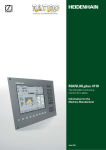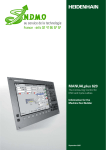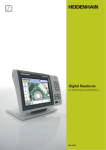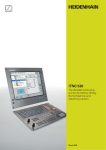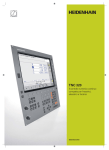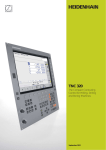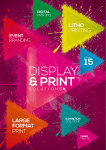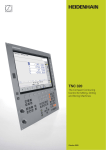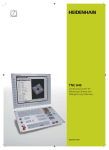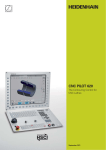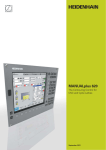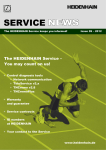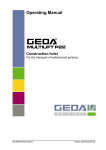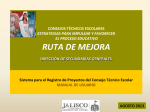Download iTNC 530
Transcript
iTNC 530
New Functions with
NC Software 340 49x-03
June 2006
New Functions with NC Software 340 49x-03
—The iTNC 530 Makes the Work Even Easier
The iTNC 530 from HEIDENHAIN has
proven itself for years as a versatile
contouring control for milling, drilling and
boring machines as well as machining
centers. Along with HEIDENHAIN’s plainlanguage conversational programming for
the shop-floor, the iTNC 530 is
characterized by many useful functions
and innovative features. To name just a
few, they include:
• Exact tool guidance with five-axis
machining
• Simple tilting of the working plane
• Practice-oriented setup functions
• Very high contour accuracy for HSC
milling
• Extensive fixed cycles
• Useful programming support through
unambiguous function keys, free contour
programming and help graphics
• Upwardly compatible part programs
• External programming and fast data
transfer
The success story of the iTNC 530 also
includes smarT.NC—the new operating
mode from HEIDENHAIN. It represents
another successful step toward a userfriendly interface for shop-floor programming. Well-structured input forms,
straightforward graphic support, and
comprehensive help texts combine with
the easy-to-use pattern generator to form a
compelling programming environment.
2
New functions for the iTNC 530
Of course there is always potential for new
development, improvement and
simplification. The NC software 340 49x-03
for the iTNC includes a series of new
functions for machine manufacturers and
users. These functions make it even easier
to work with the control, and they also
make operation of the machine more safe.
The most important are:
• TNCguide help system
• Adaptive feed rate control (AFC)
• Global program settings
• Expansion of the DXF converter
• Tool table in smarT.NC
• Expanded file management in smarT.NC
• Programming with smarT.NC during a
program run
Error fixes, expansion of functions and
options
As of NC software 340 49x-02, error fixes
were separated from software improvements. An update of NC software will
predominantly contain only error fixes.
New functions offer true added value in
user-friendliness and operational reliability.
Of course you also have the opportunity to
purchase these new functions after a
software update: These improvements in
function will be offered as “feature
upgrades,” and are enabled via the Feature
Content Level option.
If, for example, a control is updated from
34049x-02 to 34049x-03, the functions
identified with “FCL 03” in the following
tables are only available if the Feature
Content Level is set from 02 to 03. Of
course, the current feature content level
also includes the upgrade functions of the
previous NC software levels.
All of the options included in the
respective NC software can be purchased,
no matter which feature content level you
have.
Fast Availability of Information
—TNCguide Help System Integrated in the iTNC (Upgrade Function)*
Do you have questions on a programming
step but your User's Manual is not at
hand? No problem: The iTNC 530
numerical control and iTNC 530
programming station now feature
TNCguide, a convenient help system that
can show the user documentation in a
separate window.
You can activate the TNCguide by simply
pressing the help key on the iTNC
keyboard or by using the mouse. You
simply click the help symbol ( ) always
present on the TNC screen—and the
cursor becomes a moving question mark
for clicking any soft key.
The TNCguide usually displays the
information in the immediate context of
the element in question (context-sensitive
help). This means that you immediately
receive the relevant information. This
function is particularly helpful with the soft
keys. The method and effect of operation is
explained in detail.
TNCguide integrated in the control, e.g. on the iTNC 530 ...
The iTNC 530 is shipped with integrated
documentation for the respective NC
software in English and German. Other
languages are available for download free
of charge as soon as the translations
become available. After download, you can
save the national language files in the
corresponding language directory on the
TNC's hard disk.
The following manuals are available in the
help system:
• User's Manual, conversational
programming
• User's Manual, smarT.NC (pilot format)
• User's Manual, Touch Probe Cycles
• User's Manual, iTNC 530 Programming
Station (installed only for the
programming station)
… or at the Programming Station
* Only with 256 MB RAM
3
Machining According to the Conditions
—Option for Adaptive Feed Rate Control (AFC)
Besides the feed rate for each block or
cycle, HEIDENHAIN controls have always
allowed the programmer to enter a manual
compensation through the override
potentiometer to adjust for the actual
machining situation. But this always
depends on the experience and, of course,
the presence of the operator.
With Adaptive Feed Control (AFC), the feed
rate is automatically regulated by the TNC
according to the respective utilized
percentage of spindle power. This is done
with the aid of the feed-rate override factor,
which is normally calculated from the
position of the override potentiometer.
When AFC is active, this factor is no longer
derived from the potentiometer, but from
the spindle power and other process data,
from which the feed rate is calculated.
In a teach-in cut, the iTNC records the
maximum spindle power. Then, before
actual machining, you define in a table the
respective limit values between which the
iTNC can influence the feed rate in the
adaptive control mode in the “control”
mode. Of course, various overload
reactions can be specified, which can also
be defined by your machine tool builder.
4
Benefits of adaptive feed control:
• Optimizing the machining time
Fluctuations in dimensions or material
(blowholes) often appear particularly on
cast parts. With a corresponding
adaptation of the feed rate, the control
tries to keep the previously "learned"
maximum spindle power during the
entire machining time. The total
machining time is shortened by an
increased feed rate in the machining
zones with less stock removal.
• Tool monitoring:
The iTNC's adaptive feed rate control
permanently compares the spindle
power with the feed rate. As a tool
becomes blunt, the spindle power
increases. As a result, the iTNC reduces
the feed rate. As soon as the feed rate
falls below a defined minimum, the iTNC
reacts with an error message or by
switching off. This prevents damage
resulting from tool breakage or wear.
• Reduction of machine wear:
Reducing the feed rate down to the
reference value whenever the learned
maximum permissible spindle power is
exceeded also reduces the strain and
wear on the machine. It effectively
protects the spindle from overload.
New Programming Functions
—Improvements in the DXF Converter (Option)
With the DXF converter you can now also
select machining positions in addition to
contours and save them as a point table.
The following locations can be defined as
machining positions:
•
•
•
•
The beginning, end or mid-point of a line
The beginning, end or midpoint of an arc
Quadrant transitions or center of a circle
Intersection of two lines, regardless of
whether it is located inside or outside
the programmed segments
• Intersection of a line and arc
• Intersection of a line and circle
You can use the point tables generated in
the DXF converter very conveniently in
smarT.NC, however the function is also
available in conversational programming.
Selecting the machining positions
The selection of contours was simplified as
well: the design engineer does not always
define the contours so that they can be
selected directly without manual work. For
example, now you can separate laterally
joined contour elements that would
otherwise prevent contour selection. The
extension and shortening of contour
elements is now also allowed for when the
desired element limits are too far apart.
Both functions are always available, by the
way, within the contour selection mode. So
you need not decide beforehand which
elements are to be modified. The iTNC
automatically detects critical places and
indicates with symbols that the elements
have to be separated, lengthened, or
shortened.
Separating a contour element
5
New Programming Functions
—General
Global program settings (option)
The global program settings come into play
especially in large-scale mold making. It is
available in the Program Run modes and
the MDI mode. It allows you to define
various coordinate transformations and
settings with global and priority effect for
the selected NC program, without having
to edit it.
You can change the global program settings
during a program stop even in midprogram. After program start the iTNC then
moves, if necessary, to a new position with
a positioning logic influenced by you.
The following functions are available:
• Swapping axes
• Additive datum shift
• Superimposed mirroring
• Axis locking
• Handwheel superimposition, with axisspecific memory of paths covered per
handwheel
• Superimposed basic rotation
• Superimposed rotation
• Globally effective feed rate factor
Q parameter programming: string
processing
Now you can manipulate QS string
variables in various ways, for example
extract text parts or add QS text variables.
The functions find application when log
files with variable text contents are created
with the F-PRINT (FN16) function. In
various cycles you can now also define tool
names as transfer parameters.
Feed rate reduction during contour
pocket machining (upgrade function)
When a contour pocket is cleared out with
the Cycle 22 (Unit 122 in smarT.NC), the
tool is sometimes fully engaged in the
material, for example in narrow channels or
when moving to the next clearing pass.
Now you can define a percentage value by
which the iTNC reduces the feed rate in
such situations. The benefit: Machining
time is reduced because you can define a
higher standard feed rate that the iTNC
automatically reduces during full tool
engagement.
New touch probe cycles (upgrade
functions)
The group of cycles for automatic
workpiece presetting has been expanded
by the touch probe cycles 408 and 409
(Units 408 and 409 in smarT.NC). These
cycles measure the center of a slot or ridge
and write the result in any desired line of
the datum table or preset table.
In addition, touch probe cycle 4 is
introduced, which allows easy threedimensional probing.
Additional conversational languages
(option)
The conversational languages Norwegian,
Slovak, Latvian, Korean and Estonian are
available.
Time setting
A page is now available—as in a Windows
PC—for simple adjustment of the time of
day and the change to and from daylightsaving time.
Global program settings
Q parameter programming
New touch probe cycles
Additional conversational languages, e.g. Korean
6
—smarT.NC
Expanded file management
The file management in smarT.NC was
completely revised. The following functions
are available:
• smarT.NC programs (file types .HU, .HC,
HP) can now be saved in any directories.
The pop-up window for file selection was
expanded so that the user can navigate
within the window to any directories.
• File management can now be handled
completely by mouse as well as by the
familiar soft keys.
• When the file types .HP (point pattern)
and .HC (contour programs) are selected,
a preview appears showing the file
content before actual selection.
• Sorting by name, type, size, change date
and status.
• Favorites management for very quick
access to key directories.
• Fast file selection by positioning the
cursor in relation to the file name entry.
• Display of file information is configurable.
• Date display is configurable.
Contour pocket on point pattern
(upgrade function)
Any contour pocket can now be run on any
point pattern. This makes it possible to
easily define repeated machining of a
contour pocket.
Programming while machining
(upgrade function)
smarT.NC is a separate operating mode in
which you can create, test and run part
programs on the basis of editable forms.
When you start a program in this mode—
or in a full sequence-mode—you can now
also edit and create other smarT.NC
programs (.HU and .HC files) in the
programming and editing mode using
the smarT.NC user interface. With an
OPEN WITH soft key you can now choose
at any time the editor—smarT.NC or
HEIDENHAIN conversational—in which
you want to open an .HU or an .HC
program.
Tool table in smarT.NC
In the smarT.NC operating mode you can
now also edit a tool table directly. The
display of tool data is oriented to the forms
in smarT.NC. Now it presents a well
organized screen that provides a fast
overview of the existing tool data and
offers a easy editing function. As always,
smarT.NC helps you to gain a quick grasp
of the information by showing graphic
symbols that differ depending on the
defined tool type.
Positioning height in point patterns
(upgrade function)
In a point pattern, any defined machining
position can be assigned an approach
height. The tool then moves to the position
at the height that you defined, effectively
avoiding fixtures and other obstacles.
smarT.NC: New file management
smarT.NC: Editing the tool table
smarT.NC: Combining point patterns and contour pockets
smarT.NC: Variable definition of positioning heights in point patterns
7
General information
Option
FCL
Function
Standard
Mode of operation
As of NC software
Overview
—New Functions with NC Software 340 49x
40 DCM: Dynamic Collision Monitoring (only with MC 422B)
02
USB support for peripheral memory devices (memory sticks, hard disks, CD-ROMs)
02
DHCP (Domain host control protocol) and DNS (domain name server)
possible for network settings
•
Freely definable tables visible also in form view
•
All soft keys revised
340 49x-02
41 Slovenian language
•
Czech user interface now with native characters
•
Configurable update procedure for future software updates (e.g. automatic update over USB
storage devices)
•
Additional HR 420 functions:
• Selection of the active override possible on the HR 420
• Freely definable soft-key menu for machine functions
•
Smaller pop-up window when HR 420 is active, to improve legibility of axis positions on screen
•
Look-ahead can be configured via machine parameters
•
Calculation of dynamic load for tilting axes
•
Inclined tool machining with noncontrolled axes
44 Global program settings make it possible to superimpose various coordinate transformations and
settings in the Program Run operating modes
340 49x-03
45 AFC: Adaptive feed control adjusts the contouring feed rate to the spindle power
03
TNCguide: The integrated help system. User information available directly on the iTNC 530 (only
with 256 MB RAM)
41 Conversational languages in Slovak, Norwegian, Estonian, Latvian, Korean (Asian languages only
with 256 MB RAM)
smarT.NC
340 49x-02
42 Direct loading of contours from DXF files and saving as smarT.NC contouring programs
8
02
Cycles for coordinate transformation introduced
02
PLANE function introduced
02
Contour pocket: Separate depth can be assigned for each subcontour
02
Mid-program startup with graphical support
•
Cutting speed as alternate entry to the spindle shaft speed
•
Feed rate can also be entered as Fz (feed per tooth) or Fu (feed per revolution)
•
Tool data can be edited in a pop-up window during tool selection
340 49x-02
smarT.NC
Option
FCL
Function
Standard
As of NC software
Mode of operation
•
Axis keys now also position the cursor in the forms. The I key (incremental/absolute switchover)
and P key (polar/rectangular switchover) now also function for contour programming.
•
CUT/COPY/PASTE of one or more units
•
Automatic entry of workpiece blank into contour program
•
Incremental entry of machining positions in forms for machining units
•
Tooltips displayed when using the mouse
•
Navigation through the forms using the axis keys
42 DXF:
• Separation of laterally joined contour elements
• Generate point files (.HP files) directly from the DXF converter
340 49x-03
03
smarT.NC editor in the Programming and Editing operating mode
•
Expanded and completely revised file management
•
Tool table shown as a fillable form
03
Machining a contour pocket on a point pattern
03
Individually definable positioning heights in point patterns
03
Touch probe cycles for setting datums in the centerline of a slot or ridge
• 03
03
Setting of probing parameters in a separate unit
Automatic feed rate reduction in contour pockets during full tool engagement
•
Climb milling/up-cut milling during helical finish milling
•
Spindle speed of retraction during rigid tapping
•
Measured workpiece misalignment can now also be compensated by rotating a C axis
•
Zoom function in the pattern generator
•
Entry of stopping angle or angular step in a pitch circle definition
9
Conversational
programming
Option
FCL
Function
Standard
As of NC software
Mode of operation
340 49x-02
42 Reading of contours from DXF files and saving them as conversational programs
02
Cycle for global setting of touch-probe parameters
02
Point filter for smoothing NC programs created offline
02
3-D line graphics for verification of programs created offline
02
Manual traverse in the active tool-axis system
•
Cutting speed as alternate entry to the spindle shaft speed
•
Simplification when working with the preset table, incremental correction of preset values,
correction of the active preset
•
Contour pockets can now contain significantly more contour elements
•
Consideration of an active basic rotation in manual probe cycles
•
Measuring log for probing cycles can now also be displayed on the screen during program
interruption
•
FK transformation selectable as structured plain-language or linearized plain-language
340 49x-03
42 DXF:
• Separation of laterally joined contour elements
• Generate point files (.HP files) directly from the DXF converter
03
Touch probe cycles for setting datums in the centerline of a slot or ridge
03
Probing cycle for three-dimensional measurements. Results of measurement shown as desired
in the coordinate system of the tool or the machine
03
Automatic feed rate reduction in contour pockets during full tool engagement
Climb milling/up-cut milling during helical finish milling
•
Spindle speed of retraction during rigid tapping
•
Workpiece misalignment can now also be compensated by rotating a C axis
ISO
•
PLANE function also in possible in ISO
Programming
station
•
Virtual keyboard display in new version of the programming station
•
PLC program provided for optional installation (can be used to move axes)
•
Access to the PLC with the keyword “PLC”
•
All options and FCL functions are fully enabled
10
340 49x-02
•
Overview
—All Options in the NC Software 340 49x-03
Option
number
Option
Id. Nr.
Comment
0
1
2
3
4
5
6
7
Additional axis
354 540-01
353 904-01
353 905-01
367 867-01
367 868-01
370 291-01
370 292-01
370 293-01
Additional control loops 1 to 8
8
Software option 1
(for MC 420)
367 591-01
Machining with a rotary table
• Programming of cylindrical contours as if in two axes
• Feed rate in mm/min
Coordinate transformations
• Tilting the working plane, PLANE function
Interpolation
• Circular In 3 axes with tilted working plane
9
Software option 2
(for MC 420)
367 590-01
3-D machining
• Motion control with minimum jerk
• 3-D tool compensation through surface normal vectors
• Tool Center Point Management (TCPM): Using the electronic handwheel to
change the angle of the swivel head during program run without affecting the
position of the tool point
• Keeping the tool perpendicular to the contour
• Tool radius compensation perpendicular to the direction of the tool
• Manual traverse in the active tool-axis system
Interpolation
• Linear in 5 axes (export license required)
• Spline: execution of splines (3rd degree polynomial)
Block processing time 0.5 ms
18
HEIDENHAIN DNC
526 451-01
Communication with external PC applications over COM components
40
DCM Collision
526 452-01
Dynamic Collision Monitoring DCM (only with MC 422 B, MC 422 C)
41
Additional language
530 184-xx
Additional conversational language:
-01 – Slovenian
-02 – Slovak
-03 – Latvian
-04 – Norwegian
-06 – Korean1)
-07 – Estonian
42
DXF Converter
526 450-01
Load and convert DXF contours
44
Global PGM Settings
576 057-01
Global program settings
45
AFC Adaptive Feed Control
579 648-01
Adaptive feed rate control
53
FCL
529 969-01
Feature Content Level
1)
Only with 256 MB RAM
11
Serbia and Montenegro − BG
NL
CZ
HEIDENHAIN s.r.o.
106 00 Praha 10, Czech Republic
{ +420 2 72 65 81 31
E-Mail: [email protected]
HEIDENHAIN NEDERLAND B.V.
6716 BM Ede, Netherlands
{ +31 (3 18) 58 18 00
E-Mail: [email protected]
NO
TP TEKNIK A/S
2670 Greve, Denmark
{ +45 (70) 10 09 66
E-Mail: [email protected]
HEIDENHAIN Scandinavia AB
7300 Orkanger, Norway
{ +47 72 48 00 48
E-Mail: [email protected]
PH
FARRESA ELECTRONICA S.A.
08028 Barcelona, Spain
{ +34 9 34 09 24 91
E-Mail: [email protected]
Machinebanks` Corporation
Quezon City, Philippines 1113
{ +63 (2) 7 11 37 51
E-Mail: [email protected]
PL
HEIDENHAIN Scandinavia AB
02770 Espoo, Finland
{ +358 (9) 8 67 64 76
E-Mail: info@heidenhain.fi
APS
02-473 Warszawa, Poland
{ +48 2 28 63 97 37
E-Mail: [email protected]
PT
HEIDENHAIN FRANCE sarl
92316 Sèvres, France
{ +33 01 41 14 30 00
E-Mail: [email protected]
FARRESA ELECTRÓNICA, LDA.
4470 - 177 Maia, Portugal
{ +351 2 29 47 8140
E-Mail: [email protected]
RO
Romania − HU
DK
www.heidenhain.de
ES
DE
HEIDENHAIN Technisches Büro Nord
12681 Berlin, Deutschland
{ (030) 54705-240
E-Mail: [email protected]
HEIDENHAIN Technisches Büro Mitte
08468 Heinsdorfergrund, Deutschland
{ (03765) 69544
E-Mail: [email protected]
AR
GB
HEIDENHAIN (G.B.) Limited
Burgess Hill RH15 9RD, United Kingdom
{ +44 (14 44) 24 77 11
E-Mail: [email protected]
RU
HEIDENHAINTechnisches Büro Südwest
70771 Leinfelden-Echterdingen, Deutschland
{ (0711) 993395-0
E-Mail: [email protected]
Gertner Service GmbH
113035 Moskau, Russian Federation
{ +7 (4 95) 9 31-96 45
E-Mail: [email protected]
GR
SE
HEIDENHAIN Technisches Büro Südost
83301 Traunreut, Deutschland
{ (08669) 31-1345
E-Mail: [email protected]
MB Milionis Vassilis
17341 Athens, Greece
{ +30 (2 10) 9 33 66 07
E-Mail: [email protected]
HEIDENHAIN Scandinavia AB
12739 Skärholmen, Sweden
{ +46 (8) 53 19 33 50
E-Mail: [email protected]
HK
HEIDENHAIN LTD
Kowloon, Hong Kong
{ +852 27 59 19 20
E-Mail: [email protected]
SG
HEIDENHAIN PACIFIC PTE LTD.
Singapore 408593,
{ +65 67 49 - 32 38
E-Mail: [email protected]
HR
Croatia − SL
SK
Slovakia − CZ
HU
HEIDENHAIN Kereskedelmi Képviselet
1239 Budapest, Hungary
{ +36 (1) 4 21 09 52
E-Mail: [email protected]
SL
Posredništvo HEIDENHAIN
SAŠO HÜBL s.p.
2000 Maribor, Slovenia
{ +3 86 (2) 4 29 72 16
E-Mail: [email protected]
ID
PT Servitama Era Toolsindo
Jakarta 13930, Indonesia
{ +62 (21) 46 83 4111
E-Mail: [email protected]
TH
HEIDENHAIN (THAILAND) LTD
Bangkok 10250, Thailand
{ +66 (2) 3 98-41 47-8
E-Mail: [email protected]
IL
NEUMO VARGUS MARKETING LTD.
Tel Aviv 61570, Israel
{ +972 (3) 5 37 32 75
E-Mail: [email protected]
TR
T&M Mühendislik Mümessillik
34728 Erenköy-Istanbul, Turkey
{ +90 (2 16) 3 02 23 45
E-Mail: [email protected]
TW
HEIDENHAIN Co., Ltd.
Taichung 407, Taiwan
{ +886 (4) 23 58 89 77
E-Mail: [email protected]
UA
Ukraine − RU
US
HEIDENHAIN K.K.
Tokyo 102-0073, Japan
{ +81 (3) 32 34-77 81
E-Mail: [email protected]
HEIDENHAIN CORPORATION
Schaumburg, IL 60173-5337, USA
{ +1 (8 47) 4 90-11 91
E-Mail: [email protected]
VE
HEIDENHAIN LTD.
Suwon, South Korea, 443-810
{ +82 (31) 2 0115 11
E-Mail: [email protected]
Maquinaria Diekmann S.A.
Caracas, 1040-A, Venezuela
{ +58 (212) 6 32 5410
E-Mail: [email protected]
VN
AMS Advanced Manufacturing
Solutions Pte Ltd
HCM City, Viêt Nam
{ +84 (8) 912 3658 - 835 2490
E-Mail: [email protected]
ZA
MAFEMA SALES SERVICES C.C.
Midrand 1685, South Africa
{ +27 (11) 3 14 4416
E-Mail: [email protected]
NAKASE SRL.
B1653AOX Villa Ballester, Argentina
{ +54 (11) 4768 42 42
E-Mail: [email protected]
HEIDENHAIN Techn. Büro Österreich
83301 Traunreut, Germany
{ +49 (8669) 31-13 37
E-Mail: [email protected]
AU
FCR Motion Technology Pty. Ltd
Laverton North 3026, Australia
{ +61 (3) 93 626800
E-Mail: [email protected]
BE
HEIDENHAIN NV/SA
1760 Roosdaal, Belgium
{ +32 (54) 34 3158
E-Mail: [email protected]
BG
ESD Bulgaria Ltd.
Sofia 1172, Bulgaria
{ +359 (2) 9 632949
E-Mail: [email protected]
BR
DIADUR Indústria e Comércio Ltda.
04763-070 – São Paulo – SP, Brazil
{ +55 (11) 5696-67 77
E-Mail: [email protected]
BY
Belarus − RU
CA
HEIDENHAIN CORPORATION
Mississauga, Ontario L5T 2N2, Canada
{ +1 (905) 6 70-89 00
E-Mail: [email protected]
CN
FR
HEIDENHAIN Technisches Büro West
58093 Hagen, Deutschland
{ (02331) 9579-0
E-Mail: [email protected]
AT
CH
FI
HEIDENHAIN (SCHWEIZ) AG
8603 Schwerzenbach, Switzerland
{ +41 (44) 806 2727
E-Mail: [email protected]
HEIDENHAIN (TIANJIN)
OPTICS & ELECTRONICS CO., LTD
Beijing 101312, China
{ +86 10-80420000
E-Mail: [email protected]
IN
IT
JP
KR
ASHOK & LAL
Chennai – 600 030, India
{ +91 (44) 26 15 12 89
E-Mail: [email protected]
HEIDENHAIN ITALIANA S.r.l.
20128 Milano, Italy
{ +39 02 27 07 51
E-Mail: [email protected]
MK
Macedonia − BG
MX
HEIDENHAIN CORPORATION MEXICO
20235 Aguascalientes, Ags., Mexico
{ +52 (4 49) 9 13 08 70
E-Mail: [email protected]
MY
ISOSERVE Sdn. Bhd
56100 Kuala Lumpur, Malaysia
{ +60 (3) 91 32 06 85
E-Mail: [email protected]
Vollständige Adressen siehe www.heidenhain.de
For complete addresses see www.heidenhain.de
591 147-21 · 20 · 6/2006 · F&W · Printed in Germany · Subject to change without notice
Zum Abheften hier falzen! / Fold here for filing!
DR. JOHANNES HEIDENHAIN GmbH
Dr.-Johannes-Heidenhain-Straße 5
83301 Traunreut, Germany
{ +49 (86 69) 31-0
| +49 (86 69) 50 61
E-Mail: [email protected]
CS












